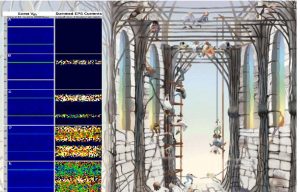Bio
“Realistic Modeling of Large Cortical Networks”
 David Beeman received his PhD in theoretical solid state physics in 1967 from the University of California, Los Angeles. He taught undergraduate physics at Harvey Mudd College from 1969 to 1990. There, he performed research in computational solid state physics, modeling the structure and vibrational properties of amorphous semiconductors, and developed tutorial simulations for undergraduate physics education.
David Beeman received his PhD in theoretical solid state physics in 1967 from the University of California, Los Angeles. He taught undergraduate physics at Harvey Mudd College from 1969 to 1990. There, he performed research in computational solid state physics, modeling the structure and vibrational properties of amorphous semiconductors, and developed tutorial simulations for undergraduate physics education.
In 1990, he came to the University of Colorado Boulder as Professor Adjunct of Electrical, Computer, and Energy Engineering and began a career in computational neuroscience. For the last 24 years, his principal activity has been the development of educational tutorials and instructional materials in computational neuroscience, using the GENESIS neural simulator, working as a subcontractor on grants funding GENESIS development, and lecturing on computer modeling of biological and artificial neural networks. Prof. Beeman has also taught the use of GENESIS and of neural simulation techniques in general at 15 international short courses that emphasize hand-on experience in neural modeling. He is a member of the CU Boulder graduate faculty of the Center for Neuroscience and is a member of the Society for Neuroscience and the Organization for Computational Neuroscience.
He is working on a large simulation of primary auditory cortex that can contribute to the understanding of the perception of combinations of musical tones. This model has also been used to study the effects of electromagnetic fields on network behavior. The simulation is being used as a tutorial with a practical example and guide to applying biologically realistic modeling to the study of cortical networks.
 Click here to view webcast.
Click here to view webcast.
Abstract
“Realistic Modeling of Large Cortical Networks”
 The human brain is large and complex with about 20 x 109 neocortical neurons and about 200 x 1012 synapses. There are dozens of varieties of neurons that have different dendritic structure and firing behavior. When modeling the neocortex, it is tempting to deal with this complexity by using simplified high-level models without spiking neurons, hoping to discover some general principles of “how the brain computes”. More realistic models often concentrate on “macroscopic realism” by emphasizing connections between different cortical areas, but with very simplified point neurons that have no dendritic structure. In this talk, I will present an argument for a more “bottom-up” approach that incorporates the best physiological data available, in order to model neurons down to details of dendritic structure, using models of the principal ion channels that are known to exist.
The human brain is large and complex with about 20 x 109 neocortical neurons and about 200 x 1012 synapses. There are dozens of varieties of neurons that have different dendritic structure and firing behavior. When modeling the neocortex, it is tempting to deal with this complexity by using simplified high-level models without spiking neurons, hoping to discover some general principles of “how the brain computes”. More realistic models often concentrate on “macroscopic realism” by emphasizing connections between different cortical areas, but with very simplified point neurons that have no dendritic structure. In this talk, I will present an argument for a more “bottom-up” approach that incorporates the best physiological data available, in order to model neurons down to details of dendritic structure, using models of the principal ion channels that are known to exist.
In this overview of structurally realistic modeling, I will use a case study of a model of primary auditory cortex that contains several thousands of multi-compartment neurons, and runs in minutes on a modern PC. This has been used to study the effect of axonal propagation delays on the propagation and interference of cortical waves, and to study the effect of electromagnetic fields on cortical activity.